Abstract
This study examines the critical interplay between migration, climate change, energy transitions, and socioeconomic disparities, highlighting their collective influence on regional resilience and sustainable development. By analyzing the existing literature, the study investigates how migration patterns are shaped by environmental stressors, energy challenges, and economic inequalities, emphasizing the dual role of migration as both a response to and a driver of climate change. Additionally, it explores the complex relationship between energy systems and migration flows, focusing on the impact of energy access, transitions, and sustainability efforts on socioeconomic conditions, particularly in vulnerable regions. The review identifies key gaps in the literature, especially regarding the economic and social implications of these interconnected factors. It also assesses how energy transitions can either mitigate or exacerbate regional disparities and resilience to climate-induced migration. This holistic perspective aims to inform future policy and research on climate migration, energy security, and socioeconomic equity.
1. Introduction
The intersection of migration, climate change, and energy transitions presents a complex set of challenges for global sustainable development. Migration, influenced by both environmental and economic factors, is a dynamic process that shapes regional economies and societies. Climate change, along with the increasing scarcity of resources and energy, is predicted to exacerbate migration patterns, particularly in regions vulnerable to environmental stressors. Consequently, enhancing regional resilience to both climate change and energy challenges is emerging as a critical area of study, carrying significant implications for policy and strategic planning.
Migration, as defined here, refers to the movement of people from one primary place of residence to another, either within a country (internal migration) or across borders (international migration). It reshapes the lives of migrants and influences both the economies and societies of origin and destination regions [1]. Migration is closely linked to broader societal, technological, demographic, and environmental shifts, including historical patterns of colonialism spanning centuries [2]. These long-standing migration flows have shaped global connections, with contemporary migration further influenced by demographic transitions. In low-fertility regions, both internal and international migrants are gradually reshaping population structures [3]. Beyond increasing population size, migration also affects demographic composition, such as age distribution and dependency ratios.
Migration refers to the relocation of individuals or households, whether temporarily (such as seasonal or circular migration) or permanently. It also includes involuntary, often short-term displacement due to unexpected events like extreme weather. Notably, in the context of climate change, migration exists on a spectrum between voluntary and forced movement, with overlapping and fluid categories. In recent years, migration has increasingly been recognized as a legitimate and potentially effective adaptation strategy to climate change [4]. Black et al. [5] emphasize that migration should be understood as part of a broader risk landscape and assessed alongside other mobility patterns driven by economic and social opportunities.
Migration, within the framework of the new mobilities paradigm, is a widespread social norm globally [6]. It plays a crucial role in sustaining the global economy and serves as a key component of livelihood diversification strategies [7,8,9]. Additionally, migration functions as a response mechanism to various external pressures and is widely recognized as an essential driver of development [9,10,11]. On an individual level, migration facilitates life transitions such as family formation and skill development, helping people and their families achieve their aspirations [12].
As mentioned above, migration occurs both internationally and internally, with international migrants consistently making up around 2.7–3.3% of the global population since 1960 [13]. Internal migration is harder to quantify due to varying measurement methods [14], but in 2005, an estimated 760 million people—roughly 12% of the global population—lived outside their region of birth [15]. Migration patterns vary widely; for example, nearly 20% of the U.S. population moved internally between 2005 and 2010, while Spain had a low internal migration rate (3%) but a high net international migration rate (48 per 1000 inhabitants). Additionally, events like the COVID-19 pandemic or war, similar to climate change [16,17,18,19,20,21,22], add complexity to migration trends, often triggering surges before lockdowns [23,24,25,26].
Szaboova et al. [26] assessed the circumstances under which migration constitutes a successful adaptation to climate change by examining the entire migration system as a social phenomenon. Like all adaptation actions, migration’s effectiveness depends on achieving sustainable outcomes for all, thereby avoiding maladaptive responses [27,28]. Sustainable adaptation in migration requires the simultaneous promotion of social equity and environmental integrity [29]. To explore the inter-temporal and social implications of migration, the authors analyze three key scenarios: intra-household dynamics in places of origin, experiences in destinations, and the connections between origin and destination through remittances. They identify three evaluation criteria—well-being, equity, and sustainability—that serve as entry points for recognizing trade-offs that could undermine migration as an adaptation strategy. For migration to be considered a successful adaptation, positive outcomes in well-being, equity, and sustainability must be observed across individuals who migrate, the communities that receive them, and the regions they leave behind, including across different temporal scales.
Climate change, migration, and energy transitions are increasingly recognized as interconnected global challenges that shape socioeconomic landscapes and regional resilience. Environmental stressors, such as rising temperatures, resource depletion, and extreme weather events, contribute to migration patterns, while energy transitions influence economic stability and development opportunities in affected regions [30]. Despite growing research on these topics, a comprehensive understanding of how these factors interact remains limited, particularly concerning their socioeconomic implications and policy responses. This study aims to bridge this gap by systematically reviewing existing literature on the interconnections between migration, climate change, energy transitions, and socioeconomic disparities. Specifically, it contributes to the field in three key ways: (1) examining migration not only as a consequence of climate change and energy challenges but also as a driver of these phenomena; (2) analyzing the role of energy systems in shaping migration patterns, particularly through access, sustainability transitions, and economic conditions; and (3) identifying critical gaps in the literature to inform future research and policy on climate migration, energy security, and socioeconomic equity.
By integrating insights from multidisciplinary studies, this research provides a holistic perspective on how environmental and energy-related stressors influence human mobility and regional sustainability. The findings contribute to ongoing discussions on climate resilience, just energy transitions, and equitable development strategies [30].
This literature review aims to explore the interconnected dynamics between migration, climate change, and energy transitions, with a focus on regional resilience. The review seeks to analyze the role of migration in shaping energy demand and regional economies, as well as the impact of climate change on migration flows and the broader implications for sustainable development. Through this review, the paper examines existing research, identifies key gaps in the literature, and proposes pathways for further exploration to foster integrated solutions to these challenges.
Objectives:
- To explore the interconnections between migration, climate change, and energy transitions, particularly how migration influenced by environmental and energy factors impacts regional resilience.
- To identify the key challenges that regions face in adapting to these interconnected pressures and how energy transitions can support or hinder regional economic resilience.
- To investigate the gaps in existing literature concerning the economic dimensions of migration, climate change, and energy, particularly the role of migration in shaping energy systems and regional economic stability.
Climate change poses a significant threat to human security by (a) disrupting livelihoods, cultural traditions, and human rights; (b) accelerating migration patterns; and (c) indirectly contributing to armed conflicts [31]. Resource scarcity, particularly regarding water due to prolonged droughts, has been identified as a factor that can intensify tensions and conflicts, either directly or indirectly [32,33]. However, the extent to which climate change contributes to conflicts compared to other socio-political and economic factors remains a topic of debate. Projected climate shifts are expected to further heighten regional energy demands and negatively impact agricultural productivity, leading to increased food insecurity, rising costs, and worsening malnutrition. These consequences may exacerbate existing social inequalities and fuel political instability, potentially escalating into conflicts and humanitarian crises [34].
Additionally, a combination of economic, political, demographic, and social pressures—alongside environmental stressors such as sea level rise, droughts, extreme heatwaves, and the spread of vector-borne diseases—can influence migration trends, with climate change acting as a key driver [9,35,36,37,38]. The scope and magnitude of climate-induced displacement could become one of the most pressing human rights challenges of the modern era [31].
Thus, migration is increasingly recognized as both a cause and consequence of climate change, with many scholars highlighting its potential to drive significant shifts in regional economies. As noted by Crescenzi, Rodríguez-Pose, and Storper [39], migration contributes not only to the redistribution of labor but also to changes in energy demand and the strain placed on regional resources. Studies by Sirkeci and Cohen [40] have further stressed the role of migration in the restructuring of urban areas, particularly in the face of climate-related disruptions. In parallel, Folke [41] discusses the concept of resilience in the context of climate change, noting that regions facing significant migration flows often struggle to maintain economic stability without integrated policies addressing both climate resilience and energy sustainability.
Furthermore, energy transitions in response to climate change can alter regional dynamics by influencing migration patterns. Research by Berkes et al. [42] illustrates the interconnectedness between resource management, migration, and resilience, emphasizing the need for systems that account for both environmental and socioeconomic pressures. While much of the current literature has focused on the social and environmental aspects of migration, the economic implications, particularly in terms of energy and regional resilience, remain underexplored. This gap in the research provides a significant opportunity for deeper analysis of how migration interacts with energy systems and how regions can better adapt to these compounded challenges.
In light of this, the present review seeks to synthesize existing research on migration, climate change, and energy transitions while exploring the economic dimensions of these interconnected phenomena. This paper contributes to the broader understanding of how regions can navigate the complexities of migration, climate adaptation, and energy sustainability in the pursuit of resilience and long-term development.
2. Research Design
The study includes a systematic literature review (SLR) based on the analysis of texts selected from databases of scientific publications—Web of Science (WoS) and Scopus. The databases were selected due to their main characteristics:
- A broad scope of international bibliography with worldwide recognition;
- Multidisciplinarity;
- A position among the leading databases of scientific texts used, among others, in bibliometric analyses but also for other purposes [43];
- Considered the most reliable sources of bibliographic data [44], having a number of requirements that determine the qualification of a text for inclusion in the database, a large number of indexed materials (with a dominant position of texts published in English), and mutual competition [45], which affects, among other things, their constant improvement and adaptation to users.
The advantages of conducting a systematic review include transparency, the possibility of replication and updating, and the avoidance of bias [46]. SLRs synthesize information following explicit methodology to answer research questions [47]. They are used to identify gaps in the literature, emerging inconsistencies, and research trends.
There was no time limit applied to the selection of scientific materials, which resulted in the acquisition of texts indexed by 11 January 2025. The constraints given were related to the four groups of keywords shown in Table 1 and connected by AND/OR operators. The arrows within the table below refer to the relationships between columns (→) and rows (↓). The selection process allowed us to extract 19 texts from the WoS database and 6 texts from the Scopus database.

Table 1.
Keywords used in the selection process of scientific texts. Source: own elaboration.
The analysis of the selected texts was undertaken separately for each database. The obtained files, in a tab-delimited and csv format, were analyzed using the VOSviewer program (version: 1.60.20), while text data from abstracts and titles were additionally analyzed using the WordArt program (an online word cloud generator). Quantitative data regarding both the selection process and the analysis performed are presented in Table 2 and supplemented for visualization purposes in Figure 1.

Table 2.
Quantitative data related to the selection process and analysis performed. Source: own elaboration.
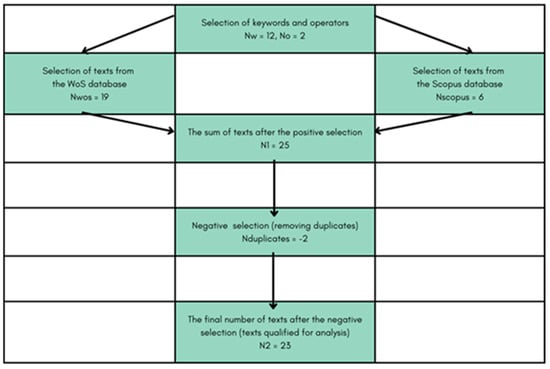
Figure 1.
Flowchart of the proposed methodology. Source: own study.
For both databases, networks were first developed based on bibliographic data (type of analysis: co-authorship and co-occurrence; full counting method), and then maps based on text data obtained from titles and abstracts (full counting method) were created. These networks and maps had an impact on the number of generated clusters, their components, and the specified nodes and links shown in the next part of the article. The analysis enabled the identification of a group of important terms that were used to develop the discussion and to draw conclusions from the research.
3. Results
3.1. Web of Science—Bibliographic Data
The analyzed topics appeared in texts published in the period from 2009 to 2024 (Figure 2). Half of the texts were available as open access. Among the indexed materials were articles published in journals (15 documents/79%), book chapters (4 documents/21%), proceeding papers, and review articles (2 documents each/10%). Most of the texts were published in English (95%) and only one in Chinese (5%).

Figure 2.
Publication years (numbers of documents). Source: own study based on WoS.
The analyzed texts were geographically categorized into 16 regions, as depicted in Figure 3. This distribution spans four continents, with a notable concentration in Europe.
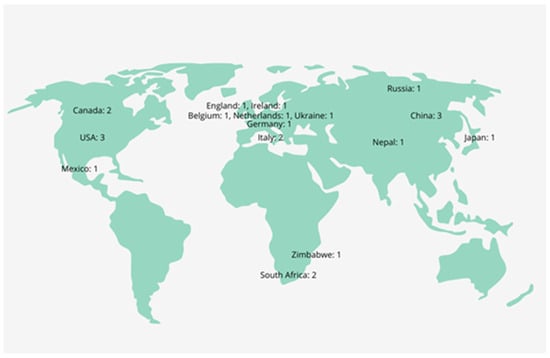
Figure 3.
Countries/regions (number of documents). Source: own study based on WoS.
In the categorization of research areas, the majority of the analyzed texts pertain to environmental science (10 documents/53%) and science and technology topics (6 documents/31%). Only two documents (10%) address economic issues, and an additional two focus on energy and fuels (details are presented in Figure 4). The analyzed texts reference fourteen Sustainable Development Goals (SDGs), as depicted in Figure 5, with the most frequent citations pertaining to goal no. 13 Climate Action and goal no. 11 Sustainable Cities and Communities.

Figure 4.
Research areas (numbers of documents). Source: own study based on WoS.
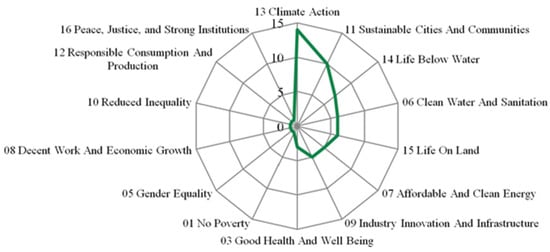
Figure 5.
Sustainable Development Goals (numbers of documents). Source: own study based on WoS.
The analysis using the VOSviewer program enabled the generation of maps of co-authorship links, indicating two groups of authors (10 people) and organizations (5 entities) involved in mutual scientific cooperation, as shown in Figure 6a,b, respectively. The Figure 6 shows, among other things, that for each text by a given author, out of the 63 authors meeting the required threshold, only 10 of them collaborated with each other within the framework of the researched issue. Similarly, in the case of cooperation between the organizations represented by the authors of the texts, out of 37 organizations meeting the required threshold, only 5 of them collaborated.
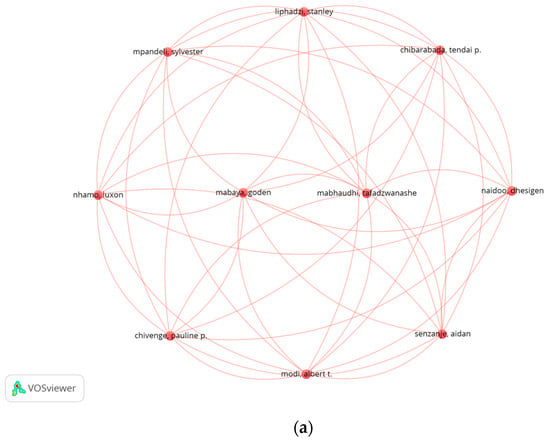
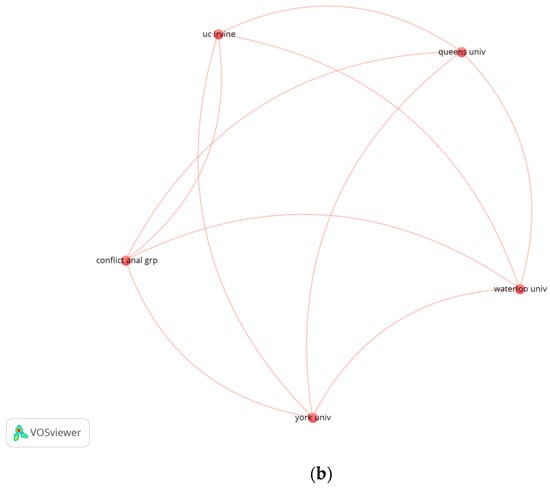
Figure 6.
Collaboration of (a) authors and (b) organizations. Source: own study based on VOSviewer. (a) Co-authorship: authors. (b) Co-authorship: organizations.
Among the most frequently cited works, the study by Hargreaves et al. [48] stands out with 395 citations. Table 3 enumerates the authors of these selected works, while Table 4 categorizes them according to their respective organizations.

Table 3.
Authors—citations (co-authorship). Source: own study.

Table 4.
Represented organizations—citations (co-authorship). Source: own study.
3.2. Web of Science—Text Data
Based on the analysis of titles and abstracts from the selected publications, a list of 1157 terms was compiled. Of these, 36 terms met the predefined criterion of appearing at least five times. Network visualization (Figure 7a) presents four thematic clusters of terms: red, containing the most terms—energy cluster, blue—migration cluster, yellow—injustice cluster, and green—geochemistry cluster. Overlay visualization (Figure 7b) shows the same terms in a timeline, indicating, among other things, that terms such as ‘sustainable development’, ‘health’, and ‘sustainable transition’ are located relatively early on the timeline, while terms such as ‘SDGs’ (Sustainable Development Goals), ‘injustice’, ‘geochemistry’, ‘China’, and ‘NSFC’ (Natural Science Foundation of China) are among the newest terms. The third map—density visualization (Figure 7c)—presents the above terms considering the intensification of their exploration by researchers in relevant fields. The map indicates, among other things, that the greatest research attention is focused on the terms ‘migration’, ‘sustainable development’, ‘health’, ‘food’, and ‘energy’. On the other hand, the least-researched issues among those appearing are those related to the terms ‘China’, ‘NSFC’, ‘ecosystem’, and ‘citizen’.
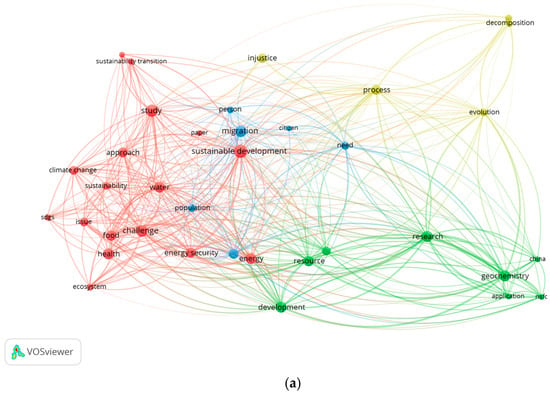

Figure 7.
Visualizations of terms. Source: own study. (a) Network visualization. (b) Overlay visualization. (c) Density visualization.
From the resulting network visualization, three distinct clusters of key terms were identified, pertaining to energy (Figure 8a–e), sustainable development (Figure 9a–h), and migration (Figure 10a–c). These clusters, along with their interconnections, are detailed in the accompanying figures. The maps below clearly outline the popularity of terms such as ‘energy’, ‘energy security’, ‘water’, ‘sustainability’, ‘sustainable development’, and ‘environment’. The terms displayed below have the highest number of interconnections with other terms. The color gradient of each term indicates the publication year of the text in which it appears; lighter hues correspond to more recent publications. For instance, the term ‘energy’ is associated with recent terms such as ‘SDGs’, ‘China’, ‘NSFC’, and ‘geochemistry’.
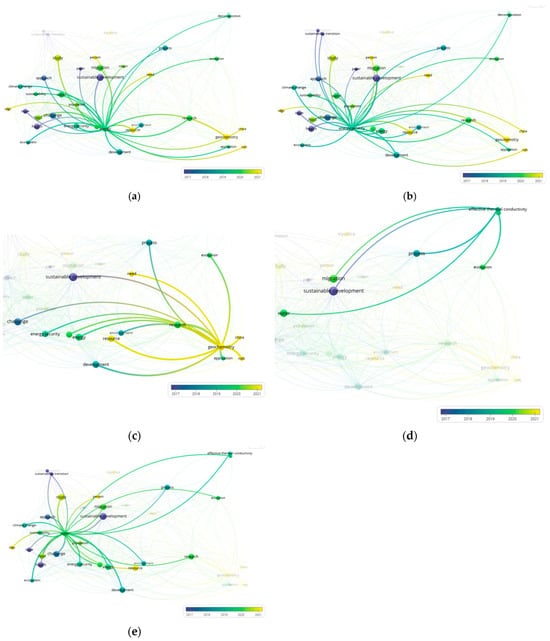
Figure 8.
Detailed links for terms relating to energy. Source: own study based on VOSviewer. (a) Term ‘energy’. (b) Term ‘energy security’. (c) Term ‘geochemistry’. (d) Term ‘effective thermal conductivity’. (e) Term ‘water’.

Figure 9.
Detailed links for terms relating to sustainability. Source: own study based on VOSviewer. (a) Term ‘sustainable peace’. (b) Term ‘sustainability transition’. (c) Term ‘sustainability’. (d) Term ‘SDGs’. (e) Term ‘ecosystem’. (f) Term ‘sustainable development’. (g) Term ‘environment’. (h) Term ‘health’.
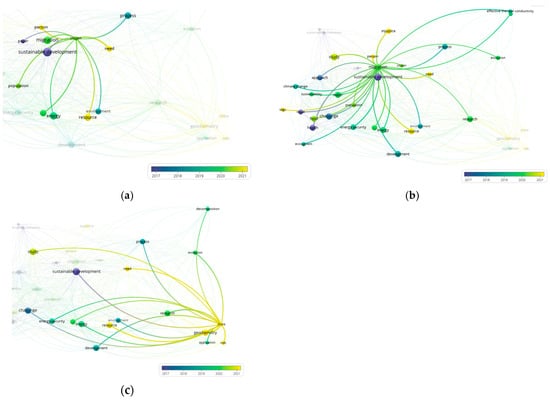
Figure 10.
Detailed links for terms relating to migration. Source: own study based on VOSviewer. (a) Term ‘citizen’. (b) Term ‘migration’. (c) Term ‘China’.
In contrast to the previously mentioned terms co-occurring with other terms, Figure 11a,b shows the frequency of words appearing in the titles and abstracts of the selected texts. The larger the font, the more often a given word appears. After excluding common words used in the text selection, the remaining prominent words are ‘security’, ‘water’, ‘challenge’, ‘geochemistry’, ‘food’, ‘nexus’ (water–energy–food nexus), ‘health’, ‘European’, ‘development’, and ‘transition’. The deliberate selection of specific terms serves multiple purposes: guiding the research focus, encouraging engagement with the published material, enhancing comprehension, and shaping readers’ perceptions. Notably, while ’energy’ is the most frequently cited term in abstracts, it does not dominate the titles; instead, ’sustainability’ prevails, highlighting a nuanced emphasis within the discourse.
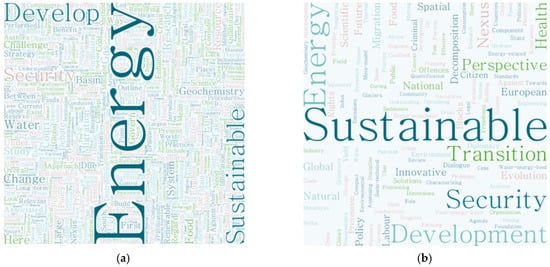
Figure 11.
Words most frequently appearing in abstracts and titles of texts selected from the WoS database. Source: own study based on WordArt. (a) Abstracts. (b) Titles.
3.3. Scopus—Bibliographic Data
The analyzed topics are addressed in publications released between 2015 and 2024. (see Figure 12). The indexed materials include a selection of articles (3 documents/50%), a book chapter, a conference paper, and a review (1 documents each/17% each), all published in English.

Figure 12.
Publication years (numbers of documents). Source: own study based on Scopus.
The analyzed texts can be geographically categorized into nine countries (Figure 13). Notably, interest in the examined topic spans three continents, with the highest concentration observed in Asia.
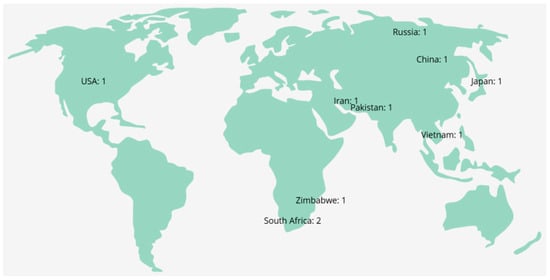
Figure 13.
Countries/regions (number of documents). Source: own study based on Scopus.
When categorized by research areas, the largest proportion of texts pertains to environmental sciences and engineering topics (4 documents each/67%). Half of the texts are thematically related to energy (Figure 14).

Figure 14.
Research areas (numbers of documents). Source: own study based on Scopus.
The analysis performed using VOSviewer software enabled the development of co-authorship network maps, highlighting ten authors, five organizations, and four countries (China, Japan, Vietnam, and Iran) actively involved in scientific collaboration, as presented in Figure 15a–c. Of the 63 authors meeting the criteria, 10 collaborated and represented five different organizations. The work by Taghizadeh-Hesary et al. [49], one of the studies from collaborating authors, ranks as the most cited, with 94 citations. Table 5 lists the authors of the selected texts referenced in the analysis, while Table 6 organizes them according to their affiliated organizations. Their division by represented countries is presented in Table 7.
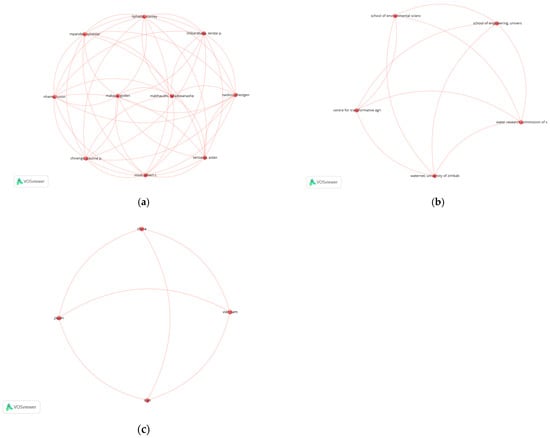
Figure 15.
Collaboration of (a) authors, (b) organizations, and (c) countries. Source: own study based on VOSviewer. (a) Co-authorship: authors. (b) Co-authorship: organizations. (c) Co-authorships: countries.

Table 5.
Authors—citations (co-authorship).

Table 6.
Represented organizations—citations (co-authorship).

Table 7.
Represented countries—citations (co-authorship).
3.4. Scopus–Text Data
By analyzing the titles and abstracts, a list of 324 terms was compiled. Among these, 25 terms met the predefined criterion of occurring at least three times. Within the framework of Figure 16a, network visualization indicates the existence of four thematic clusters of terms: red—climate change cluster, blue—energy security cluster, yellow—energy cluster, and green—SDGs cluster. Next, visualization (Figure 16b) shows that terms such as ‘energy transition’ and ‘sustainability’, among others, are the oldest terms, while terms such as ‘energy’, ‘Pakistan’, and environmental security’ are the newest terms. The density visualization map (Figure 16c) indicates that the terms ‘energy’ and ‘climate change’ receive the highest research focus, whereas terms such as ‘Sustainable Development Goals’, ‘economic development’, and ‘energy security’ are comparatively less explored.
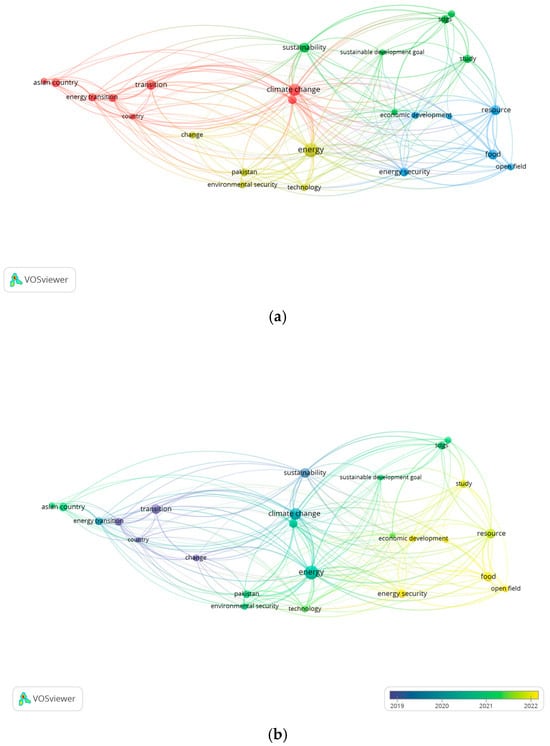
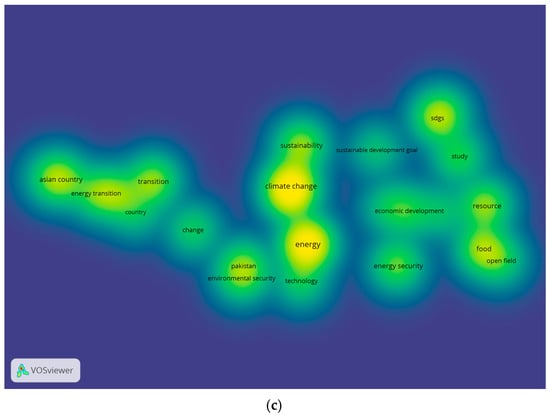
Figure 16.
Visualizations of terms. Source: own study. (a) Network visualization. (b) Overlay visualization. (c) Density visualization.
The generated connection maps reveal three distinct groups of key terms associated with energy (Figure 17a–d), sustainable development (Figure 18a–e), and migration (Figure 19a–d), along with their detailed linkages to other terms. The maps clearly highlight the prominence of terms such as ‘energy’, ‘energy security’, ‘climate change’, and ‘migration’. Recent research has introduced terms such as ‘energy security’ and ‘food security’ as emerging areas of focus. Conversely, ‘economic development’, though less prevalent in terms of interconnections, has also gained attention in recent studies.
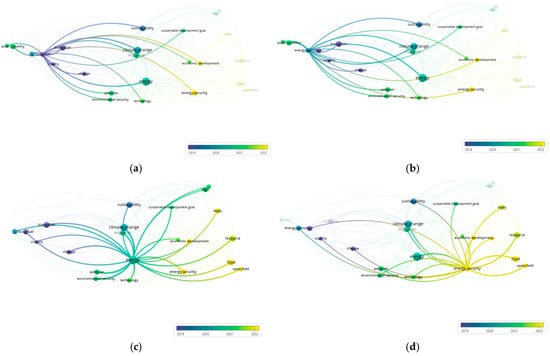
Figure 17.
Detailed links for terms relating to energy. Source: own study based on VOSviewer. (a) Term ‘fossil fuel’. (b) Term ‘energy transition’. (c) Term ‘energy’. (d) Term ‘energy security’.
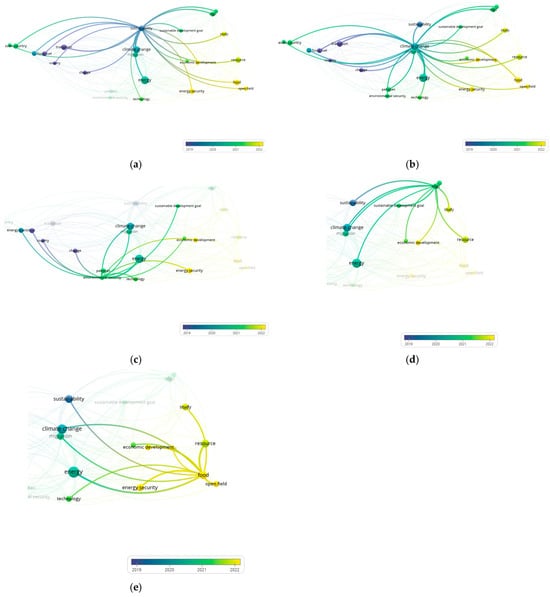
Figure 18.
Detailed links for terms relating to sustainability. Source: own study based on VOSviewer. (a) Term ‘sustainability’. (b) Term ‘climate change’. (c) Term ‘environmental security’. (d) Term ‘SDGs’. (e) Term ‘food’.
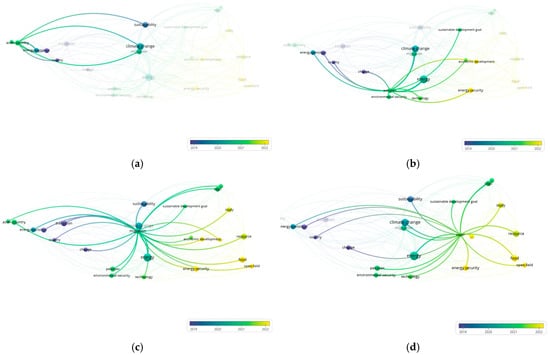
Figure 19.
Detailed links for terms relating to migration. Source: own study based on VOSviewer. (a) Term ‘Asian country’. (b) Term ‘Pakistan’. (c) Term ‘migration’. (d) Term ‘economic development’.
Figure 20a,b presents the most frequently appearing words in the titles and abstracts of the selected texts from the Scopus database. In addition to the words used in the text selection process, the following words appear most frequently: ‘transition’, ‘security’, ‘climate’, ‘develop’, ‘nexus’, and ‘physics’. Due to the shorter length of titles compared to abstracts, the number of unique terms in titles is significantly lower. Nonetheless, the terms ’energy’ and ’security’ prominently appear in both titles and abstracts.
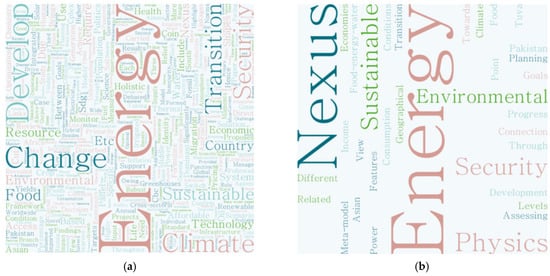
Figure 20.
Words most frequently appearing in abstracts and titles of texts selected from the Scopus database. Source: own study based on WordArt. (a) Abstracts. (b) Titles.
3.5. Interconnections Between Migration, Climate Change, and Energy Transitions
Twenty-two selected articles were analyzed regarding interconnections between migration, climate change, and energy transitions. Observations regarding groups of co-occurring approaches are presented in Table 8.

Table 8.
Energy, migration, and climate change approaches presented in the analyzed articles (chronological order).
4. Discussion
The conducted research allowed us to specify the terms important for the research topic:
- Terms popular in the past among researchers: ‘sustainable development’, ‘health’, ‘sustainable transition’, ‘energy transition’, and ‘sustainability’;
- Terms currently popular among researchers: ‘SDGs’, ‘injustice’, ‘geochemistry’, ‘China’, ‘NSFC’, ‘energy’, ‘Pakistan’, and ‘environmental security’;
- Terms most explored: ‘migration’, ‘sustainable development’, ‘health’, ‘food’, ‘energy’, and ‘climate change’;
- Terms with a low level of exploration: ‘China’, ‘NSFC’, ‘ecosystem’, ‘citizen’, ‘sustainable development goals’, ‘economic development’, and ‘energy security’;
- Terms with many connections to other terms: ‘energy’, ‘energy security’, ‘water’, ‘sustainability’, ‘sustainable development’, ‘environment’, ‘climate change’, and ‘migration’;
- Terms most frequently appearing in titles and abstracts: ‘security’, ‘water’, ‘challenge’, ‘geochemistry’, ‘food’, ‘nexus’, ‘health’, European’, ‘development’, ‘transition’, ‘climate’, and ‘physics’.
4.1. Terms: ‘Energy’, ‘Energy Transition’, ‘Energy Security’, and ‘Water’
4.1.1. Migration in the Context of Energy, Energy Transition, Energy Security, and Water
Migration, as a response to environmental and socioeconomic factors, plays a critical role in addressing challenges related to energy, energy transitions, energy security, and water resources. The growing intersection of migration with these issues emphasizes the need for a broader understanding of how migration can influence and be influenced by sustainable energy development, energy access, and water management.
Slow-onset climate events, such as rising sea levels, have long-term, gradual impacts on migration patterns, often resulting in the displacement of entire communities over an extended period. These events force individuals and communities to move due to the slow degradation of livable conditions, including the salinization of freshwater sources, agricultural loss, and the inundation of low-lying areas [70]. In contrast, sudden-onset events, like floods or hurricanes, often lead to immediate displacement but may be temporary depending on the recovery efforts [23]. While floods can result in abrupt, short-term migration flows, slow-onset events tend to push people into more permanent or long-term migration, creating shifts in population distribution over time. These patterns are critical for understanding how climate change reshapes migration processes, especially in coastal and island regions [25].
Renewable energy projects can significantly influence migration patterns by creating new job opportunities, reducing the need for urban migration, and enhancing community resilience to climate impacts. These projects play an essential role in both adapting to and mitigating the effects of climate change, which often drive migration from vulnerable areas. In regions heavily dependent on fossil fuels, the transition to renewable energy can trigger economic shifts that may result in labor migration, as workers in these areas seek new opportunities in green industries. However, renewable energy projects must strike a balance between economic benefits and social impacts to ensure that migration patterns are not adversely affected by rapid transitions. As such, these projects help create stable, local energy sources, improve living conditions, and reduce migration to urban centers by providing employment in rural or energy-deprived regions.
However, an often-overlooked factor in migration dynamics is energy poverty, which refers to a lack of access to reliable and affordable energy. Energy poverty directly affects livelihoods, education, and healthcare, often forcing people to migrate in search of better living conditions. Addressing energy poverty through renewable energy projects can reduce forced migration by improving economic stability in vulnerable communities.
In Southeast Asia, for example, climate change impacts such as droughts and floods have forced many agricultural workers to seek employment through cross-border labor migration corridors. Many workers from Cambodia and Myanmar migrate to Thailand through the Border Employment Scheme or irregular channels to work on small-scale sugarcane plantations. However, they often face exploitative working conditions, lack social protections, and remain vulnerable to climate hazards such as heatwaves and floods [71].
While labor migration can serve as a coping strategy, it has its limitations. Without access to energy resources, economic mobility remains constrained. Many migrants move to urban areas or foreign countries because their home regions lack electricity for businesses, irrigation systems, or modern education. Without proper labor protections, migration can become maladaptive, increasing vulnerabilities rather than reducing them [72]. Renewable energy investments can help mitigate these challenges by providing stable employment opportunities, improving agricultural productivity, and reducing migration pressures.
Table 9 outlines the diverse ways renewable energy projects influence migration, including how these projects can reduce climate-induced migration by enhancing resilience in vulnerable regions, particularly in relation to energy poverty. Renewable energy infrastructure, such as wind, solar, and hydroelectric power stations, can directly mitigate the adverse effects of climate change by improving energy access and sustainability in rural and underserved areas. This, in turn, reduces the necessity for people to migrate from these areas due to climate impacts, such as droughts, floods, or extreme weather events [73].

Table 9.
The impact of renewable energy projects on migration patterns.
Additionally, migration itself can serve as an adaptation strategy. As people are forced to migrate due to environmental changes, renewable energy projects can help mitigate climate-induced migration by creating sustainable livelihoods for these displaced populations [71].
Several global initiatives actively engage in climate mobility, supporting the idea that migration is both a response to and a strategy for adapting to climate change. Table 10 provides a list of key projects that address the intersection of migration and climate action, demonstrating the potential for migration to be leveraged as a tool for climate adaptation and development.

Table 10.
Key climate action projects and their impact on migration.
For instance, the IOM Diaspora for Climate Action (D4C) Project involves diaspora communities from countries such as Albania, Bangladesh, Ghana, and Jamaica in shaping climate strategies, including nationally determined contributions (NDCs) and national adaptation plans (NAPs). This initiative underscores the role of diasporas in contributing to climate resilience in their countries of origin [71]. Similarly, the Pacific Australia Labour Mobility (PALM) Scheme allows workers from the Pacific Islands to work in Australia’s agricultural sector, gaining valuable skills that they can later apply to climate-resilient agricultural practices in their home countries [79].
These projects illustrate how migration can serve as an adaptation strategy by facilitating the transfer of skills and resources between regions. The Kyrgyz Diaspora Climate Action Project also shows how diaspora communities can contribute both financially and technically to climate resilience efforts in Kyrgyzstan, enhancing local adaptation strategies [71].
4.1.2. Energy and Migration
Migration can significantly affect energy demand and supply in both origin and destination areas. In regions experiencing high levels of outmigration, the shift in population density can alter local energy consumption patterns, potentially reducing demand in depopulated areas or increasing it in areas of migration influx. Conversely, migrants often face challenges in accessing reliable and affordable energy in destination areas, particularly in urban slums or informal settlements. This can lead to energy poverty, hindering their ability to participate in sustainable energy transitions [81].
4.1.3. Energy Transition and Migration
The global shift toward renewable energy and low-carbon technologies—referred to as the energy transition—has the potential to impact migration patterns. As regions strive to reduce reliance on fossil fuels, migration can serve as both a coping strategy and a contributor to sustainable energy initiatives. Migrants may bring with them skills and expertise in renewable energy technologies or become integral to green energy projects in their host communities. However, these transitions can also create tensions, as energy-dependent industries in migrant-origin areas may face disruption, pushing individuals to seek opportunities elsewhere [82]. The resulting migration flows can challenge existing energy infrastructure, particularly in urban areas, if not managed appropriately.
4.1.4. Energy Security and Migration
Energy security—the reliable availability of energy at affordable prices—remains a crucial issue in the context of migration. Migrants, especially those fleeing climate-induced disasters or energy-poor regions, often find themselves in vulnerable positions regarding access to energy. This is particularly problematic in areas where energy infrastructure is already stretched thin or where political instability affects energy provisioning. As migration increases, energy demands in receiving areas rise, requiring adequate planning for sustainable energy access to avoid exacerbating energy insecurity for both migrant and local populations [9]. Moreover, migration itself can be both a result of and a contributor to energy security challenges, as populations displaced by energy shortages or environmental degradation often move in search of stable energy access.
4.1.5. Water Resources and Migration
Migration is closely linked to water scarcity and access to clean water, especially in regions where water resources are increasingly under stress due to climate change, overuse, or pollution. In some cases, water scarcity has directly driven migration, with individuals and families leaving water-stressed regions for areas where water is more readily available. Conversely, large influxes of migrants into urban centers or rural communities can strain local water systems, exacerbating competition for this critical resource. Effective water management is essential to ensure that migration does not further strain already limited water resources in receiving areas. Ensuring equitable access to water for both migrants and host communities is a significant challenge, particularly in regions facing significant water scarcity [83].
The interlinkages between migration, energy, energy security, and water resources (see Table 11) highlight the importance of integrating these dimensions into both migration and sustainability policies. Migrants, particularly in regions vulnerable to climate change, have the potential to contribute to and benefit from energy and water management strategies, but their needs must be addressed in planning processes to ensure sustainable, equitable outcomes for all.

Table 11.
Migration in the context of energy, energy transition, energy security, and water.
Migration is a highly uncertain process, especially when it comes to forced or asylum-related migration, which is associated with the highest levels of uncertainty. Consequently, most quantitative asylum migration models focus on single drivers in countries of origin (e.g., conflicts) [84,85,86] or destination (e.g., migration or asylum policies) [87]. While some more comprehensive asylum migration models have been developed, they often aim to increase retrospective understanding [88,89,90,91] or provide alerts [92] rather than forecasting flows, with exceptions mostly confined to the prediction of single country-to-country flows [93].
On the other hand, machine learning algorithms can be effectively utilized to predict future migration hotspots. A study by Carammia, Iacus, and Wilkin [93] introduced an adaptive machine learning approach that integrates administrative statistics with non-traditional data sources to forecast asylum-related migration flows. This method analyzes various data tiers—including geolocated events, internet search trends, border crossing detections, and asylum recognition rates—to predict migration patterns up to four weeks in advance. The approach monitors migration drivers in both origin and destination countries, models individual country-to-country flows with moving time windows, estimates the effects of various drivers (including lagged effects), and assesses how these patterns shift over time. Importantly, this methodology is adaptable and can be applied in different contexts where adequate migration or asylum data are available. Their approach uniquely monitors drivers in both origin and destination countries to detect early changes, models individual country-to-country migration flows separately using moving time windows, estimates the effects of individual drivers—including lagged effects—and delivers forecasts of asylum applications up to four weeks ahead [93].
This approach represents a significant advancement over previous models that often addressed single migration drivers in isolation. By incorporating a broader range of data sources and modeling techniques, the algorithm provides a more nuanced understanding of the dynamic factors influencing asylum-related migration, thereby improving the accuracy and reliability of migration forecasts.
4.2. Terms: ‘Sustainable Transition’, ‘Nexus’, ‘Environmental Security’, ‘SDSs’/’Sustainable Development Goals’, ‘Climate Change’, and ‘Ecosystem’
4.2.1. Migration and Climate Change
Although climate change is recognized as a significant factor influencing migration, the term ‘climate migrant’ and its equivalents remain subjects of legal and scientific debate. Efforts to quantify future migration linked to climate change continue to be contested and uncertain [94].
From a political perspective, the principle of ‘leaving no one behind’ is a key pillar of the Sustainable Development Goals (SDGs), emphasizing the need for inclusive policies. Achieving universal health coverage is recognized as dependent on the inclusion of migrants [95]. During the 21st Conference of Parties (COP21) under the United Nations Framework Convention on Climate Change (UNFCCC) in Paris, a task force was created to develop recommendations on addressing displacement linked to climate change [96]. The Platform on Disaster Displacement, succeeding the Nansen Initiative, seeks to implement protections for cross-border displaced persons [97]. According to Szaboova et al. [26] the role of migration as a potential adaptation to climate change is increasingly acknowledged. However, there is limited understanding of whether migration constitutes a successful adaptation, under what conditions, and for whom. Based on a review of emerging migration research, authors argue that migration can be considered a successful adaptation strategy if it enhances well-being, reduces inequality, and supports sustainability. These three dimensions serve as key indicators for evaluating trade-offs within and across different social and temporal scales, which could potentially challenge the effectiveness of migration as an adaptive response. Assessing the success of migration as an adaptation strategy requires a multi-scalar approach that considers several critical factors. These include the depopulation of source areas, the climate-related risks faced in destination regions, and the material and non-material flows that shape economic and social interactions between these areas. Understanding these dynamics is essential for integrating migration into policy frameworks as a viable adaptation option. By making migration more visible and measurable within adaptation planning, policymakers can better address the opportunities and challenges it presents in the context of climate change.
Migration in the context of climate change exists along a spectrum from voluntary to forced movement, with fluid and overlapping categories. In the past decade, migration has increasingly been acknowledged as a legitimate and potentially effective response to climate challenges. Black et al. [9] argue that migration is embedded within broader risk dynamics and should be assessed alongside other forms of mobility driven by economic and social opportunities.
4.2.2. Migration and Sustainable Development
Migration plays a complex role in shaping sustainability outcomes across economic, social, and environmental dimensions. Its impact depends on factors such as the size and composition of migration flows, policy frameworks, and socioeconomic contexts [1,98]. While migration fosters economic growth, social mobility, and innovation, it also poses challenges such as labor market disruptions, brain drain, and increased resource demands [99,100]. The relationship between migration and sustainability (see Table 12) remains contentious, influenced by diverse analytical perspectives and political interpretations [98].
The impact of migration on sustainability is largely mediated by changes in human capital, labor supply, and physical resources [81]. Sustained migration flows may reduce income per capita due to capital dilution—where available resources are spread across a larger population [100]. However, migration also contributes to human capital formation, particularly if migrants bring high levels of education and skills [101]. The labor market effects of migration remain mixed, depending on the demographic composition of migrants and their substitutability with native workers [100].
Migration influences both source and destination areas, with economic, social, and environmental implications [1,102]. Remittances play a crucial role in development by supporting education, healthcare, and infrastructure in migrants’ home countries [1,102]. At the same time, migration alters consumption patterns and environmental footprints. Some studies highlight a positive correlation between migration and CO2; emissions, as migrants often adopt higher-consumption lifestyles in destination countries [103,104]. Conversely, migration can foster sustainability by facilitating knowledge transfer and improving resilience to environmental stressors [23,82].
Scholars emphasize the importance of recognizing migrant communities as key stakeholders in sustainability planning. Migrants bring valuable knowledge, perspectives, and experiences that can enhance sustainability transitions [81]. However, their voices are often excluded from formal policy discussions [105]. Research shows that integrating diverse perspectives into inclusive knowledge systems leads to more effective and transformative action [106]. Migrant networks influence migration policy outcomes, while restrictive entry and integration policies shape migrants’ ability to contribute to sustainability transitions [1,107]. Migration infrastructure—including institutions, technologies, and social networks—also plays a crucial role in shaping mobility patterns [108].
Migration affects community resilience and resource sustainability by redistributing populations and altering land use patterns [109]. Population growth influences resource demand, while migration-induced shifts in population density impact agricultural and natural resources [83]. Case studies indicate that migrants often perceive sustainability as an integrated concept encompassing social goals, economic opportunities, and urban livability [110].
The UNHCR Global Strategy for Sustainable Energy 2019–2025 aims to provide refugees and host communities with safe, sustainable, and environmentally responsible energy solutions, focusing on renewable energy to reduce environmental impact and improve well-being [111]. Refugees often face energy poverty, relying on harmful sources like diesel generators, which harm health and the environment [112]. Renewable energy solutions offer cleaner, sustainable alternatives, improving living conditions and fostering socioeconomic development. IRENA’s report on refugee settlements in Iraq and Ethiopia suggests solar energy systems and mini-grids to address unreliable power sources and improve energy access. In Iraq, solar systems with battery banks can reduce voltage fluctuations, while in Ethiopia, solar mini-grids can provide immediate electricity access, reducing reliance on polluting fuels. Large-scale solar parks could benefit both refugees and host communities. Renewable energy improves quality of life, safety, and productivity for refugees, stimulates economic growth, and reduces operational costs for humanitarian organizations [112]. These solutions can help alleviate energy poverty and support long-term resilience and development for both displaced populations and host communities.
A key paradox in migration research is its dual role in sustainability. Migration fuels economic globalization, which can intensify sustainability challenges, while also serving as a mechanism for positive social and environmental transformation [81]. Some studies suggest that migration contributes to global carbon emissions [103,104] whereas others highlight its role in building resilience and adaptive capacity [82,113]. This paradox underscores the need for empirical research across spatial and temporal scales to assess migration’s long-term sustainability impacts.
From a policy perspective, effective labor migration management must address contemporary challenges such as demographic shifts, labor market mismatches, and geopolitical uncertainties [114]. Policies should balance labor market flexibility with migrant rights protection to maximize sustainability benefits [115]. However, governance remains fragmented, with migration and sustainability policies often treated in isolation [116]. While the Sustainable Development Goals (SDGs) represented progress by incorporating migration into select targets, integration remains limited [117]. The International Organization for Migration (IOM) advocates for sustainable reintegration pathways for returning migrants, yet these efforts are often disconnected from broader sustainability planning [118].

Table 12.
Migration and sustainability—key dynamics.
Table 12.
Migration and sustainability—key dynamics.
| Aspect | Positive Impacts | Negative Impacts | Key Sources |
|---|---|---|---|
| Economic effects | Remittances boost development, entrepreneurship, innovation | Brain drain, labor market competition | Skeldon [99]; Docquier and Rapoport [101] |
| Social mobility | Access to education, job opportunities, improved well-being | Social integration challenges, inequality | de Haas [1]; Lyu [119] |
| Environmental impact | Knowledge exchange, sustainable urban practices | Increased CO2 emissions, higher consumption | Liang et al. [103]; Shi et al. [104]; Hunter and Nawrotzki [120] |
| Labor market impact | Reduces unemployment in source areas, fills labor gaps | Wage suppression, competition with native workers | Boubtane et al. [100]; Gavonel et al. [81] |
| Governance and policy | Supports demographic balance, drives policy innovation | Fragmented governance, exclusion from planning | Fukuda-Parr [116]; Piper [117]; IOM [118] |
Source: own study.
Migration plays a critical role in shaping sustainability outcomes, offering both opportunities and challenges for economic development, environmental resilience, and social equity. The ambiguous nature of migration’s sustainability effects highlights the need for evidence-based policymaking and integrated governance approaches. Future research should focus on understanding migration’s long-term impact on sustainability transitions and designing policies that leverage migration’s potential while mitigating its risks.
To effectively address the energy needs of growing urban populations due to climate-induced migration, collecting and analyzing migration data are essential. Governments and energy planners must anticipate shifts in population density to prevent energy shortages, power grid failures, and increased energy poverty in rapidly expanding urban areas. Accurate migration data helps identify areas where off-grid renewable energy solutions can be implemented to support displaced communities. Forecasting migration trends allows policymakers to design sustainable energy policies that accommodate urban growth. Regional energy planning can be optimized by integrating migration data with climate risk assessments to reduce the burden on already strained energy grids [74,78]. By investing in real-time migration tracking and energy planning, governments can enhance resilience, ensuring that climate-induced migration does not lead to chronic energy poverty in expanding urban areas.
4.3. Terms: ‘Pakistan’, ‘China’, and ‘NSFC’
Migration patterns in Pakistan and China have become increasingly intertwined with energy, environmental security, and sustainability concerns. Both countries are facing significant challenges related to climate change, resource scarcity, and rapid urbanization, all of which have contributed to changing migration trends. Pakistan, for instance, is heavily impacted by water scarcity and energy insecurity, with large portions of the population migrating from rural areas affected by droughts, water scarcity, and energy shortages toward urban centers in search of better living conditions and job opportunities. This migration, however, places increasing pressure on urban infrastructure, straining local energy systems and resources in the receiving regions [56,60].
In China, migration has been driven by both environmental factors, such as climate-induced disasters and water scarcity, and economic opportunities in urban areas, particularly those related to the energy sector [104]. Rural-to-urban migration, often spurred by the search for better living standards, has been coupled with the rapid industrialization and urbanization of cities, resulting in increased energy demand and air pollution. Moreover, the NSFC (National Natural Science Foundation of China) has supported various research efforts aimed at understanding how migration interacts with energy transitions and environmental changes in China. Studies funded by the NSFC explore the relationship between migration flows and energy consumption, examining how changes in population dynamics may either ease or exacerbate the challenges surrounding energy security and environmental sustainability [58,67]. These studies aim to inform policy decisions on managing migration in the context of energy transitions and securing sustainable resource management.
In both countries, migration intersects with energy transition efforts. For example, the growing demand for energy in urban areas driven by migration poses a challenge for energy systems, especially in countries like Pakistan, where energy insecurity is a persistent issue. At the same time, migration flows could also contribute to energy solutions, as individuals with expertise in renewable energy technologies may migrate to areas where their skills are needed to support the transition to low-carbon energy systems [48]. In China, the shift to renewable energy sources has been partly influenced by migration trends, as workers with skills in renewable technologies contribute to new energy projects, helping to integrate sustainable energy practices into urban development [50].
NSFC-funded research continues to play a significant role in understanding the complex interactions between migration, energy security, and environmental sustainability. Through its support, the NSFC facilitates studies that investigate the dual role of migration as both a response to and a driver of energy and environmental challenges, providing critical insights into how migration can be managed to support sustainable development goals. Additionally, the research underscores the need to incorporate migration considerations into energy and climate change policies to achieve more sustainable and equitable outcomes [49,67].
4.4. Terms: ‘Geochemistry’ and ‘Physics’
In the context of migration, geochemistry and physics are among the least economically relevant topics, which is why we approach them in a broad and general manner. Rather than focusing on aspects such as effective thermal conductivity or the transition from fossil fuels to renewable energy sources—topics that, while significant in scientific discourse, do not directly relate to human migration—we prioritize social, political, and economic factors that drive and shape migratory movements. Studies on migration, such as those by de Haas, Castles, and Miller [13], emphasize the importance of structural economic conditions, labor markets, and geopolitical factors over purely physical or geochemical considerations. While environmental conditions, including climate change, can influence migration patterns [9], the role of geochemical and physical properties remains secondary in most analyses. However, some studies have explored the connection between migration and geochemistry or physics, particularly in relation to environmental change. For example, Black et al. [9] discuss how soil degradation, desertification, and extreme weather events increase migration pressures. Warner et al. [121] highlight the loss of water resources and changes in soil chemistry as key migration drivers, especially in vulnerable regions. Scheffran et al. [122] analyze how geochemical changes and resource depletion contribute to social tensions and forced displacement. Henry et al. [123] examine rainfall variability and its effects on soil water balance, which in turn shape agricultural migration patterns. McLeman and Smit [124] consider migration as an adaptive response to environmental stressors such as soil degradation, hydrological shifts, and erosion (Table 13).

Table 13.
Migration in the context of geochemistry and physics.
4.5. Terms: ‘Health’, ‘Food’, and ‘Citizen’
Migration intersects with several global challenges, with health, food security, and citizenship standing out as key components that shape both the causes and consequences of migration. Understanding these issues in relation to migration can provide deeper insights into how to manage the dynamics between migrant populations and host societies, as well as address global sustainability goals.
4.5.1. Health and Migration
Migration, particularly in the context of climate change, displacement, and economic hardship, often impacts the health of individuals and communities [94,125,126].
Migrants are frequently exposed to health risks during their journey, including increased vulnerability to infectious diseases, mental health challenges due to trauma, and limited access to healthcare upon arrival in destination areas [127]. These challenges are compounded by a lack of adequate healthcare infrastructure in migrant-receiving areas, particularly in informal settlements and overcrowded urban areas. Migrants may also encounter barriers to health insurance or public health services, exacerbating health inequalities. Conversely, migration can also have positive health outcomes, particularly when migrants gain access to better healthcare, sanitation, or nutrition in destination areas. Additionally, migrants may bring with them valuable public health knowledge and cultural practices that can contribute to community health [105].
4.5.2. Food and Migration
Migration and food security are intimately connected, as migrants often face food insecurity both during and after their move. In destination areas, migrants may experience limited access to affordable, nutritious food, especially in urban slums or rural areas with inadequate supply chains. This can lead to malnutrition, poor health, and exacerbated vulnerability, especially among women, children, and the elderly. Additionally, migration can impact food systems in both sending and receiving areas. Large-scale migration can strain local food resources, especially in communities that already experience food insecurity. A study by Schwerdtle et al. [94] underscores that food and water security are important mediators between climate change, human mobility, and health outcomes.
On the other hand, migrants can contribute to food security in host areas through labor in agricultural sectors, food production, and the transfer of agricultural knowledge and practices from their regions of origin [119]. In some cases, migrants bring new food practices that can diversify diets and improve nutrition.
4.5.3. Citizenship and Migration
The concept of citizenship plays a significant role in migration dynamics, influencing the rights and opportunities available to migrants. Access to citizenship—or a lack thereof—affects migrants’ ability to integrate into host societies, access social services, and participate in economic and political processes. In many countries, migrants face barriers to obtaining citizenship or even permanent residency, which can limit their access to essential services like healthcare, education, and social security. The lack of formal citizenship status may also contribute to marginalization and social exclusion, further exacerbating inequalities. On the other hand, granting citizenship or offering pathways to citizenship for migrants can lead to positive outcomes for both migrants and host societies, fostering greater social cohesion, labor force participation, and economic development [100]. Furthermore, migrants who become citizens often play a significant role in shaping the cultural and social fabric of the host society, enriching the local community.
In conclusion, the interconnectedness of health, food, and citizenship with migration underscores the importance of integrating these factors into comprehensive migration policies. Addressing health challenges, ensuring food security, and facilitating access to citizenship are critical in promoting sustainable and equitable migration outcomes. Policymakers should prioritize these dimensions in both sending and receiving areas to ensure that migration contributes positively to human development and well-being for all involved.
The relation between migration, health, food, and citizenship is presented in Table 14.

Table 14.
Migration in the context of health, food, and citizenship.
Climate-induced migration is reshaping population distribution in urban areas, as displaced rural populations often move to cities seeking better economic opportunities and essential services. This rapid urbanization places significant pressure on housing, energy supply, and public infrastructure. In cities experiencing climate displacement, informal settlements often expand, increasing vulnerability to overcrowding, inadequate energy access, and exposure to climate hazards [73]. In Bangladesh, for example, coastal erosion and rising sea levels have driven rural populations to Dhaka, where they face unstable housing and insufficient energy infrastructure. Similarly, in Sub-Saharan Africa, prolonged droughts have forced migration to urban centers, leading to higher energy demand that often surpasses supply capacity [74]. Without planned urban expansion and investment in renewable energy infrastructure, climate-induced migration can overwhelm energy grids and public services, increasing inequality in access to resources.
5. Conclusions
The reviewed literature demonstrates the growing intersection between energy security, migration, climate change, and sustainability across diverse global regions. Several studies highlight that migration is not only a consequence of environmental degradation and climate change but also a significant factor influencing energy security and sustainability. In Pakistan, for example, migration driven by water scarcity and energy insecurity is putting pressure on urban areas, exacerbating the demand for energy and resource management [60]. Similarly, in China, the dynamics of migration in rural areas related to climate-induced changes, such as water scarcity, are crucial to understanding how energy transitions and climate policy can be shaped [67].
The relationship between energy transformation and migration is also explored, with findings suggesting that migration may either be a driver of or a response to energy transitions. As regions shift to renewable energy systems, the migration of workers with expertise in renewable technologies could help mitigate challenges posed by energy demand in urban areas [48,49]. In other instances, migration could exacerbate challenges related to energy security, especially in regions facing significant socioeconomic inequality and resource depletion [68].
Migration, climate change, and energy systems are deeply interconnected in shaping migration processes. Climate-induced environmental changes, such as rising temperatures, desertification, and extreme weather events, often push populations to migrate in search of better living conditions and access to resources. These migration patterns, in turn, affect energy demand and infrastructure in both sending and receiving regions. As migrants relocate to urban centers or regions with better economic prospects, energy consumption rises, creating additional pressure on local energy supplies and sustainability efforts [128]. Simultaneously, migration can support energy transitions by providing labor for renewable energy projects, particularly in areas investing in wind, solar, and hydroelectric power. However, disparities in energy access between regions can also exacerbate socioeconomic inequalities, influencing migration decisions. The bidirectional relationship between migration and energy transitions highlights the need for integrated policies that address climate resilience, sustainable energy development, and equitable migration management.
Furthermore, the role of climate change in altering migration patterns and its direct impact on energy systems are highlighted in various studies. Climate-induced migration, such as that driven by melting glaciers in the Himalayas or environmental changes in Tuva, has significant implications for both energy systems and socioeconomic structures [63,69]. The combined effects of these interconnected factors point to the need for a more integrated approach to policy development that addresses energy transitions, migration flows, and climate change.
Socioeconomic disparities further complicate migration dynamics, as unequal access to resources and energy systems exacerbate vulnerabilities in certain populations. Marginalized communities, often already living under precarious economic conditions, are disproportionately affected by climate change, which forces them to migrate in search of better opportunities [70,129]. The disparities in access to energy between regions push economically disadvantaged individuals to move toward urban centers, where energy resources are more abundant, but often lead to greater competition for jobs and housing [130,131]. These economic pressures create a feedback loop where migration driven by inequality can also contribute to increasing social and economic disparities in destination areas [122,132].
Akrofi et al. [68] highlight that labor migration is one of the consequences of injustices within renewable energy projects. The exploitation of natural resources for clean energy initiatives can place significant pressure on local resources, leading to the displacement and dispossession of communities. This not only results in the loss of land for these communities but also stimulates labor migration as individuals are forced to seek new economic opportunities elsewhere. This issue is particularly relevant in areas where the push for renewable energy projects may inadvertently contribute to new forms of social and economic inequality [68].
Additionally, Koliesnik et al. [65] emphasize that attacks on critical infrastructure increase the demand for certain professions, including those related to energy security, leading to mass layoffs in other sectors. This creates another layer of complexity, as the dynamics of labor migration intersect with broader societal and economic changes triggered by shifts in the energy sector. As both migration and energy transitions become more complex, it is evident that policy solutions must address the interconnections between these issues to ensure sustainable, equitable, and resilient outcomes for both migrants and host communities.
These findings highlight the need for integrated strategies that combine migration management, energy security, and climate change mitigation to promote sustainable development in regions experiencing rapid demographic and environmental changes. By considering these factors in policy design, governments can create systems that not only support energy transitions but also ensure the protection and empowerment of migrant communities.
As a result, the complex relationship between migration, climate change, health, and energy transitions requires a multi-dimensional approach to evaluate its role in sustainable development. Migration often has both positive and negative effects on the sustainability of both origin and destination areas. While migration can offer individuals opportunities to improve their well-being through better job prospects and access to education, it also raises challenges such as increased pressure on local resources and potential environmental degradation in destination areas. At the same time, migration can enhance the ability of both individuals and communities to adapt to climate change by diversifying income sources, facilitating the transfer of knowledge, and contributing to the sustainable management of natural resources [1,119].
Climate change is increasingly recognized as a driver of migration, especially in areas prone to extreme weather events and rising sea levels. However, migration also presents a means of adaptation, enabling individuals and communities to move away from high-risk areas [9]. Health risks linked to climate change, such as heat stress and the spread of diseases, further complicate the dynamic, necessitating an inclusive approach that integrates healthcare, infrastructure, and migration management [83,110]. As migration patterns increase, the need for policies that ensure equitable access to healthcare and safeguard health systems becomes critical, as migrants are often exposed to heightened vulnerability in terms of climate-related health risks [113].
Energy transitions, likewise, present both challenges and opportunities for migrants. Migrants contribute to energy needs, but they also bring skills that can support sustainable energy initiatives, from renewable energy development to low-carbon transport solutions [82,103]. By addressing the intersection of these factors, migration can be harnessed as a tool for both adaptation to climate change and the achievement of broader sustainability goals. Migrants, by integrating into labor markets, can contribute to sustainable energy production, which is key for global energy transitions in the context of climate change [108].
This evaluation framework, with its key dimensions (Table 15), offers a starting point for examining the multifaceted role of migration in the context of climate change adaptation and the broader goal of sustainable development. Understanding the trade-offs and balancing the interests of different stakeholders, from migrants to host communities, is crucial to ensuring that migration can effectively contribute to resilience and sustainability in a changing world.

Table 15.
Migration, climate change, health, energy transitions, and socioeconomic equity: dimensions of success, trade-offs, and metrics.
Ultimately, the research underscores the need for interdisciplinary solutions and policy frameworks that consider the intersection of migration, energy, and climate change. These challenges must be addressed holistically, ensuring that migration is seen as both a response and a contributor to sustainable development and climate resilience, especially in countries like Pakistan, China, and regions impacted by rapid environmental changes. Further research is needed to explore the impacts of migration on energy transitions, focusing on how migration can be both a tool for sustainable development and a challenge to resource management in vulnerable regions. Future research should focus on understanding how migration influences climate change impacts, particularly in terms of reducing risks and potential negative effects on both origin and destination areas, such as resource use and infrastructure strain. It is also crucial to explore how migration affects energy demand and the role migrants play in promoting sustainable energy, as well as their access to renewable energy. Further investigation is needed into the health risks faced by migrants due to climate-induced factors, ensuring equitable healthcare access. Additionally, research should explore migration’s social, economic, and environmental trade-offs, especially regarding remittances, labor redistribution, and social mobility. Long-term studies on migrant communities’ resilience and integration into labor markets will help inform sustainable development strategies. Finally, understanding migration’s impact on water resource management in regions facing scarcity is key to developing adaptive policies. Addressing these areas will enhance our understanding of migration’s role in climate adaptation and sustainability.
Furthermore, given the diverse mobility patterns emerging in the context of climate change, flexible approaches are needed that address the vulnerabilities of communities at risk of or experiencing forced migration while supporting the adaptive potential of mobility strategies. It is essential to develop policies that effectively protect health and its determinants, particularly food and water security, regardless of the climate scenario. Further analysis is required to ensure the meaningful integration of climate data into research on migration and health in the context of a changing climate, maintaining high quality in this evolving field of nexus research. Migrant-inclusive and climate-resilient health systems have the potential to mitigate the most severe health impacts of climate-related migration. It seems important that research and policy related to migration also consider the links between climate change and health and that migration is considered a determinant of health in climate change and health research [94].
In conclusion, supporting sustainable energy transitions like recycling and waste-to-energy initiatives is crucial for regions affected by climate-induced migration. These solutions can address energy shortages, reduce environmental impacts, and create new employment opportunities for displaced populations.
Waste-to-energy technologies offer a renewable energy source, reducing reliance on fossil fuels, while recycling helps conserve resources and reduce landfill waste. These strategies not only improve energy access and sustainability but also foster resilience and self-sufficiency in both displaced and host communities. By integrating these solutions, regions can enhance their adaptation to climate change, creating a more sustainable future for all [111,112].
The main limitations of the conducted research are related to the disadvantages of SLR, which include, among others, overly rigorous selection criteria, subjectively determined complexity of the issue, the exclusion of gray literature (no additional searches outside the databases), and limitation to publications published in specific languages [133]. The aforementioned considerations also pertain to the limitations intrinsically linked to the study’s focus. These limitations encompass the limited depth of analysis concerning stakeholder interests, interdisciplinary methodologies, the role of migration as a catalyst for sustainable development, its ramifications for energy consumption, the trade-offs inherent in migration processes, and health protection directives, among other facets. The latter of these limitations constitutes a group of research gaps complementary to those resulting directly from the results section of this article and concerning terms related to currently underexplored topics such as ‘China’, ‘NSFC’, ‘ecosystem’, ‘citizen’, ‘Sustainable Development Goals’, ‘economic development’, and ‘energy security’.
Author Contributions
Conceptualization, K.Ł.-D., K.M.-W. and M.Ł.; methodology, K.Ł.-D. and K.M.-W.; software, K.Ł.-D. and K.M.-W.; validation, K.Ł.-D. and K.M.-W.; formal analysis, K.M.-W.; investigation, K.M.-W.; resources, K.Ł.-D. and K.M.-W.; data curation, K.Ł.-D. and K.M.-W.; writing—original draft preparation, K.Ł.-D. and K.M.-W.; writing—review and editing, K.Ł.-D. and K.M.-W.; visualization, K.M.-W.; supervision, K.Ł.-D. and K.M.-W.; project administration, K.Ł.-D. and K.M.-W.; funding acquisition, M.Ł., K.Ł.-D. and K.M.-W. All authors have read and agreed to the published version of the manuscript.
Funding
This work was financially supported by the Opole University of Technology as part of the DELTA project no. 247/23.
Conflicts of Interest
The authors declare no conflicts of interest.
References
- De Haas, H. Paradoxes of migration and development. In Handbook of Migration and Development; Bastia, T., Skeldon, R., Eds.; Routledge: London, UK, 2020; pp. 17–31. [Google Scholar]
- Barnett, J.; Adger, W.N. Mobile worlds: Choice at the intersection of demographic and environmental change. Annu. Rev. Environ. Resour. 2018, 43, 245–265. [Google Scholar] [CrossRef]
- Coleman, D. Immigration and ethnic change in low-fertility countries: A third demographic transition. Popul. Dev. Rev. 2006, 32, 401–446. [Google Scholar]
- Doria, M.d.F.; Boyd, E.; Tompkins, E.L.; Adger, W.N. Using expert elicitation to define successful adaptation to climate change. Environ. Sci. Policy 2009, 12, 810–819. [Google Scholar] [CrossRef]
- Black, R.; Bennett, S.R.G.; Thomas, S.M.; Beddington, J.R. Migration as adaptation. Nature 2011, 478, 447–449. [Google Scholar] [PubMed]
- Sheller, M.; Urry, J. The new mobilities paradigm. Environ. Plan. A Econ. Space 2006, 38, 207–226. [Google Scholar]
- Stark, O.; Bloom, D.E. The new economics of labor migration. Am. Econ. Rev. 1985, 75, 173–178. [Google Scholar]
- De Haan, A. Livelihoods and poverty: The role of migration-a critical review of the migration literature. J. Dev. Stud. 1999, 36, 1–47. [Google Scholar]
- Black, R.; Adger, W.N.; Arnell, N.W.; Dercon, S.; Geddes, A.; Thomas, D. The effect of environmental change on human migration. Glob. Environ. Change 2011, 21, S3–S11. [Google Scholar] [CrossRef]
- Skeldon, R. Migration and Development: A Global Perspective; Routledge: London, UK, 2014. [Google Scholar]
- De Haas, H.; Czaika, M.; Flahaux, M.-L.; Mahendra, E.; Natter, K.; Vezzoli, S.; Villares-Varela, M. International migration: Trends, determinants, and policy effects. Popul. Dev. Rev. 2019, 45, 885–922. [Google Scholar]
- Bernard, A.; Bell, M.; Charles-Edwards, E. Life-course transitions and the age profile of internal migration. Popul. Dev. Rev. 2014, 40, 213–239. [Google Scholar] [CrossRef]
- De Haas, H.; Castles, S.; Miller, M.J. The Age of Migration: International Population Movements in the Modern World; Bloomsbury Publishing: London, UK, 2019. [Google Scholar]
- Bell, M.; Charles-Edwards, E.; Kupiszewska, D.; Kupiszewski, M.; Stillwell, J.; Zhu, Y. Internal migration data around the world: Assessing contemporary practice. Popul. Space Place 2015, 21, 1–17. [Google Scholar] [CrossRef]
- Bell, M.; Charles-Edwards, E. Cross-National Comparisons of Internal Migration: An Update on Global Patterns and Trends; Technical Paper; United Nations Department of Economic and Social Affairs, Population Division: New York, NY, USA, 2013; Volume 1. [Google Scholar]
- Farbotko, C.; Kitara, T.; Dun, O.; Evans, C. A climate justice perspective on international labour migration and climate change adaptation among Tuvaluan workers. Oxf. Open Clim. Change 2022, 2, kgac002. [Google Scholar] [CrossRef]
- Kaczan, D.J.; Orgill-Meyer, J. The impact of climate change on migration: A synthesis of recent empirical insights. Clim. Change 2020, 158, 281–300. [Google Scholar] [CrossRef]
- Castells-Quintana, D.; Krause, M.; McDermott, T.K.J. The urbanising force of global warming: The role of climate change in the spatial distribution of population. J. Econ. Geogr. 2021, 21, 531–556. [Google Scholar] [CrossRef]
- Lu, X.; Wrathall, D.J.; Sundsøy, P.R.; Nadiruzzaman, M.; Wetter, E.; Iqbal, A.; Qureshi, T.; Tatem, A.; Canright, G.; Bengtsson, L. Unveiling hidden migration and mobility patterns in climate stressed regions: A longitudinal study of six million anonymous mobile phone users in Bangladesh, global environmental change. Glob. Environ. Change 2016, 38, 1–7. [Google Scholar] [CrossRef]
- Hugo, G. Future demographic change and its interactions with migration and climate change. Glob. Environ. Change 2011, 21, S21–S33. [Google Scholar]
- Bardsley, D.K.; Hugo, G.J. Migration and climate change: Examining thresholds of change to guide effective adaptation decision-making. Popul. Environ. 2010, 32, 238–262. [Google Scholar]
- Perch-Nielsen, L.S.B.; Bättig, M.; Imboden, D. Exploring the link between climate change and migration. Clim. Change 2008, 91, 375–393. [Google Scholar] [CrossRef]
- Adger, W.N.; Arnell, N.W.; Black, R.; Dercon, S.; Geddes, A.; Thomas, D.S. Focus on environmental risks and migration: Causes and consequences. Environ. Res. Lett. 2015, 10, 060201. [Google Scholar]
- Piguet, E.; Pécoud, A.; De Guchteneire, P. Migration and climate change: An overview. Refug. Surv. Q. 2011, 30, 1–23. [Google Scholar]
- McLeman, R. Climate and Human Migration: Past Experiences, Future Challenges; Cambridge University Press: Cambridge, UK, 2013. [Google Scholar]
- Szaboova, L.; Adger, W.N.; de Campos, R.S.; Maharjan, A.; Sakdapolrak, P.; Sterly, H.; Conway, D.; Codjoe, S.N.A.; Abu, M. Evaluating migration as successful adaptation to climate change: Trade-offs in well-being, equity, and sustainability. One Earth 2023, 6, 620–631. [Google Scholar] [CrossRef]
- Eriksen, S.; Brown, K. Sustainable adaptation to climate change. Clim. Dev. 2011, 3, 3–6. [Google Scholar] [CrossRef]
- Schipper, E.L.F. Maladaptation: When adaptation to climate change goes very wrong. One Earth 2020, 3, 409–414. [Google Scholar] [CrossRef]
- Eriksen, S.; Schipper, E.L.F.; Scoville-Simonds, M.; Vincent, K.; Adam, H.N.; Brooks, N.; Harding, B.; Khatri, D.; Lenaerts, L.; Liverman, D.; et al. Adaptation interventions and their effect on vulnerability in developing countries: Help, hindrance or irrelevance? World Dev. 2021, 141, 105383. [Google Scholar] [CrossRef]
- Zhang, J.; Yang, Z.; He, B. Empowerment of Digital Technology for the Resilience of the Logistics Industry: Mechanisms and Paths. Systems 2024, 12, 278. [Google Scholar] [CrossRef]
- Koubi, V.; Behnassi, M.; Elia, A.; Grillakis, M.; Turhan, E. Human security. In Climate and Environmental Change in the Mediterranean Basin—Current Situation and Risks for the Future; Cramer, W., Guiot, J., Marini, K., Eds.; First Mediterranean Assessment Report, Union for the Mediterranean, Plan Bleu; UNEP/MAP: Nairobi, Kenya, 2020; pp. 515–538. [Google Scholar]
- Gleick, P.H. Water, drought, climate change, and conflict in Syria. Weather. Clim. Soc. 2014, 6, 331–340. [Google Scholar] [CrossRef]
- Kelley, C.P.; Mohtadi, S.; Cane, M.A.; Seager, R.; Kushnir, Y. Climate change in the Fertile Crescent and implications of the recent Syrian drought. Proc. Natl. Acad. Sci. USA 2015, 112, 3241–3246. [Google Scholar] [CrossRef]
- Zittis, G.; Almazroui, M.; Alpert, P.; Ciais, P.; Cramer, W.; Dahdal, Y.; Fnais, M.; Francis, D.; Hadjinicolaou, P.; Howari, F.; et al. Climate change and weather extremes in the Eastern Mediterranean and Middle East. Rev. Geophys. 2022, 60, e2021RG000762. [Google Scholar]
- Abel, G.J.; Brottrager, M.; Crespo Cuaresma, J.; Muttarak, R. Climate, conflict and forced migration. Glob. Environ. Change 2019, 54, 239–249. [Google Scholar] [CrossRef]
- Davy, R.; Gnatiuk, N.; Pettersson, L.; Bobylev, L. Climate change impacts on wind energy potential in the European domain with a focus on the Black Sea. Renew. Sustain. Energy Rev. 2018, 81, 1652–1659. [Google Scholar] [CrossRef]
- Lelieveld, J.; Proestos, Y.; Hadjinicolaou, P.; Tanarhte, M.; Tyrlis, E.; Zittis, G. Strongly increasing heat extremes in the Middle East and North Africa (MENA) in the 21st century. Clim. Change 2016, 137, 245–260. [Google Scholar] [CrossRef]
- Tabari, H.; Willems, P. More prolonged droughts by the end of the century in the Middle East. Environ. Res. Lett. 2018, 13, 104005. [Google Scholar] [CrossRef]
- Crescenzi, R.; Rodriguez-Pose, A.; Storper, M. The territorial dynamics of innovation: A Europe–United States comparative analysis. J. Econ. Geogr. 2007, 7, 673–709. [Google Scholar] [CrossRef]
- Sirkeci, I.; Cohen, J.H. Cultures of migration and conflict in contemporary human mobility in Turkey. Eur. Rev. 2016, 24, 381–396. [Google Scholar] [CrossRef]
- Folke, C. Resilience (republished). Ecol. Soc. 2016, 21, 44. [Google Scholar] [CrossRef]
- Berkes, F.; Folke, C.; Colding, J. (Eds.) Linking Social and Ecological Systems: Management Practices and Social Mechanisms for Building Resilience; Cambridge University Press: Cambridge, UK, 2000. [Google Scholar]
- Zhu, J.; Liu, W. A Tale of Two Databases: The Use of Web of Science and Scopus in Academic Papers. Scientometrics 2020, 123, 321–335. [Google Scholar] [CrossRef]
- Pranckutė, R. Web of Science (WoS) and Scopus: The Titans of Bibliographic Information in Today’s Academic World. Publications 2021, 9, 12. [Google Scholar] [CrossRef]
- Joshi, A. Comparison between Scopus & ISI Web of Science. J. Glob. Values 2016, VII, 2454–8391. [Google Scholar]
- Scottish Government. Scottish Government Social Research Group Social Sciences Methods Series. Guide 5: Systematic Reviews. 2009. Available online: https://www.gov.scot/binaries/content/documents/govscot/publications/advice-and-guidance/2009/12/social-research-methods-guides/documents/systematic-reviews/systematic-reviews/govscot%3Adocument/Systematic%2BReviews.pdf (accessed on 19 January 2025).
- Sataloff, R.T.; Bush, M.L.; Chandra, R.; Chepeha, D.; Rotenberg, B.; Fisher, E.W.; Goldenberg, D.; Hanna, E.Y.; Kerschner, J.E.; Kraus, D.H.; et al. Systematic and other reviews: Criteria and complexities. J. Otolaryngol. Head Neck Surg. 2021, 50, 41. [Google Scholar] [CrossRef]
- Hargreaves, T.; Hielscher, S.; Seyfang, G.; Smith, A. Grassroots innovations in community energy: The role of intermediaries in niche development. Glob. Environ. Change 2013, 23, 868–880. [Google Scholar] [CrossRef]
- Taghizadeh-Hesary, F.; Rasoulinezhad, E.; Shahbaz, M.; Vinh, X.V. How energy transition and power consumption are related in Asian economies with different income levels? Energy 2021, 237, 121595. [Google Scholar] [CrossRef]
- Levy, J.K. A case for sustainable security systems engineering: Integrating national, human, energy and environmental security. J. Syst. Sci. Syst. Eng. 2009, 18, 385–402. [Google Scholar] [CrossRef]
- French, W.; Meyer, S. Forming the Building Blocks of a Sustainable Environment: How Dialogue and Public Diplomacy Yield Innovative Solutions. In Sustainable Environmental Design in Architecture. Springer Optimization and Its Applications; Rassia, S.T., Pardalos, P.M., Eds.; Springer: New York, NY, USA, 2012; Volume 56. [Google Scholar] [CrossRef]
- Negri, S. Sustainable Development and Global Health: Positioning Health in the Post-2015 Development Agenda. In Environmental Protection and Sustainable Development from Rio to Rio+20; BRILL-Martinus Nijhoff Publishers: Leiden, The Netherlands, 2014; pp. 264–285. [Google Scholar] [CrossRef]
- Tomkiewicz, M. Energy and sustainability, from the point of view of environmental physics. MRS Energy Sustain. 2015, 2, 13. [Google Scholar] [CrossRef][Green Version]
- Brauch, H.G.; Oswald Spring, Ú. Sustainability Transition and Sustainable Peace: Scientific and Policy Context, Scientific Concepts and Dimensions. In Handbook on Sustainability Transition and Sustainable Peace. Hexagon Series on Human and Environmental Security and Peace; Brauch, H., Oswald Spring, Ú., Grin, J., Scheffran, J., Eds.; Springer: Cham, Switzerland, 2016; Volume 10. [Google Scholar] [CrossRef]
- Greene, M. Socio-technical transitions and dynamics in everyday consumption practice. Glob. Environ. Change 2018, 52, 1–9. [Google Scholar] [CrossRef]
- Masih, A. Thar Coalfield: Sustainable Development and an Open Sesame to the Energy Security of Pakistan. J. Phys. 2018, 989, 012004. [Google Scholar] [CrossRef]
- Singh, V.P. Sustainable Urban Ecosystems: Problems and Perspectives. In Urban Ecology, Water Quality and Climate Change; Sarma, A., Singh, V., Bhattacharjya, R., Kartha, S., Eds.; Water Science and Technology Library; Springer: Cham, Switzerland, 2018; Volume 84. [Google Scholar] [CrossRef]
- Wei, R.P.; Yang, L.; Zhao, J.F.; Wang, J.; Wang, Y.L.; Ling, Z.; Li, Y.H.; Yang, M.J.; Song, J.C. Evolution of effective thermal conductivity during hydrate formation and decomposition in natural sediments. Energy Procedia 2019, 158, 5825–5831. [Google Scholar] [CrossRef]
- Carlier, J.Y.; Crépeau, F.; Purkey, A. From the 2015 European Migration Crisis to the 2018 Global Compact for Migration: A Political Transition Short on Legal Standards. McGill Int. J. Sustain. Dev. Law Policy 2020, 16, 34–81. [Google Scholar]
- Hassan, M.; Khan, M.I.; Mumtaz, M.W.; Mukhtar, H. Energy and Environmental Security Nexus in Pakistan. Adv. Sci. Technol. Secur. Appl. 2021, 25, 147–172. [Google Scholar] [CrossRef]
- Mabhaudhi, T.; Nhamo, L.; Chibarabada, T.P.; Mabaya, G.; Mpandeli, S.; Liphadzi, S.; Senzanje, A.; Naidoo, D.; Modi, A.T.; Chivenge, P.P. Assessing Progress towards Sustainable Development Goals through Nexus Planning. Water 2021, 13, 1321. [Google Scholar] [CrossRef]
- Smolenaars, W.J.; Lutz, A.F.; Biemans, H.; Dhaubanjar, S.; Immerzeel, W.W.; Ludwig, F. From narratives to numbers: Spatial downscaling and quantification of future water, food & energy security requirements in the Indus basin. Futures 2021, 133, 102831. [Google Scholar] [CrossRef]
- Talukder, B.; Matthew, R.; van Loon, G.W.; Bunch, M.J.; Hipel, K.W.; Orbinski, J. Melting of Himalayan glaciers and planetary health. Curr. Opin. Environ. Sustain. 2021, 50, 98–108. [Google Scholar] [CrossRef]
- Ogbolumani, O.A.; Nwulu, N.I. A food-energy-water nexus meta-model for food and energy security. Sustain. Prod. Consum. 2022, 30, 438–453. [Google Scholar] [CrossRef]
- Koliesnik, T.; Lehkosherst, Y.; Zhdan, M. Socio-economic component of the state policy in the field of prevention of criminal offences against labour rights and freedoms if a person and a citizen. Balt. J. Econ. Stud. 2023, 9, 128–133. [Google Scholar] [CrossRef]
- Rezaei Kalvani, S.; Celico, F. The Water–Energy–Food Nexus in European Countries: A Review and Future Perspectives. Sustainability 2023, 15, 4960. [Google Scholar] [CrossRef]
- Zuo, Z.; Li, Y.; Guo, H.; Cheng, J. Spatial evolution and decomposition of energy-related CO2 emissions in China’s mining industry: From the perspective of regional heterogeneity. Environ. Sci. Pollut. Res. 2023, 30, 101599–101615. [Google Scholar] [CrossRef] [PubMed]
- Akrofi, M.M.; McLellan, B.C.; Okitasari, M. Characterizing ‘injustices’ in clean energy transitions in Africa. Energy Sustain. Dev. 2024, 83, 101546. [Google Scholar] [CrossRef]
- Sambuu, A. Features of the climate of Tuva in connection with physical and geographical conditions. BIO Web Conf. 2024, 118, 02011. [Google Scholar] [CrossRef]
- Rigaud, K.K.; Heuser, S.; Abu-Ata, N.; Arora, A. Operational Experiences and Lessons Learned at the Climate Migration Development Nexus: A World Bank Portfolio Review with a Focus on Sub-Saharan Africa; World Bank: Washington, DC, USA, 2021. [Google Scholar]
- IOM. International Migration in a Changing Climate: Insights from Malaysia and Thailand. In Thinking About Tomorrow, Acting Today: The Future of Climate Mobility; Vigil, S., Kim, D., Eds.; International Organization for Migration: Geneva, Switzerland, 2023. [Google Scholar]
- Vinke, K.; Bergmann, J.; Blocher, J.; Upadhyay, H.; Hoffmann, R. Migration as adaptation? Migr. Stud. 2020, 8, 626–634. [Google Scholar] [CrossRef]
- Birkmann, J.; Liwenga, E.; Pandey, R.; Boyd, E.; Djalante, R.; Gemenne, F.; Leal Filho, W.; Pinho, P.F.; Stringer, L.; Wrathall, D. Poverty, Livelihoods and Sustainable Development. In Climate Change 2022: Impacts, Adaptation and Vulnerability. Contribution of Working Group II to the Sixth Assessment Report of the Intergovernmental Panel on Climate Change; Pörtner, H.-O., Roberts, D.C., Tignor, M., Poloczanska, E.S., Mintenbeck, K., Alegría, A., Craig, M., Langsdorf, S., Löschke, S., Möller, V., et al., Eds.; Cambridge University Press: Cambridge, UK; New York, NY, USA, 2022; pp. 1171–1274. [Google Scholar] [CrossRef]
- ILO. Global Employment Trends for Youth 2022: Investing in Transforming Futures for Young People; International Labour Organization: Geneva, Switzerland, 2022. [Google Scholar]
- IEA. The Importance of Focusing on Jobs and Fairness in Clean Energy Transitions; International Energy Agency: Paris, France, 2021. [Google Scholar]
- ILO. Skills for a Greener Future: A Global View; International Labour Organization: Geneva, Switzerland, 2019. [Google Scholar]
- Black, R.; Adger, W.N.; Arnell, N.W.; Dercon, S.; Geddes, A.; Thomas, D. Migration and global environmental change: Future challenges and opportunities. Foresight Lond. 2011.
- Mason, N.; Gençsü, I.; Feyertag, J.; Löwe, A. Migration for Climate Action: How Labour Mobility Can Help the Green Transition; ODI: London, UK, 2022. [Google Scholar]
- Dun, O.; Klocker, N.; Farbotko, C.; McMichael, C. Climate change adaptation in agriculture: Learning from an international labour mobility programme in Australia and the Pacific Islands region. Environ. Sci. Policy 2023, 139, 250–273. [Google Scholar] [CrossRef]
- Migration Partnership Facility. (E)Co-Development for Innovation and Employment in Green and Circular Economy Between Andalusia and Morocco (MOVE_GREEN); Migration Partnership Facility: Brussels, Belgium, 2021. [Google Scholar]
- Gavonel, M.F.; Adger, W.N.; Safra de Campos, R.; Boyd, E.; Carr, E.R.; Fábos, A.; Fransen, S.; Jolivet, D.; Zickgraf, C.; Codjoe, S.N.; et al. The migration-sustainability paradox: Transformations in mobile worlds. Curr. Opin. Environ. Sustain. 2021, 49, 98–109. [Google Scholar] [CrossRef]
- Tebboth, M.; Conway, D.; Adger, W.N. Mobility endowment and entitlements mediate resilience in rural livelihood systems. Glob. Environ. Change 2019, 54, 172–183. [Google Scholar] [CrossRef]
- Rees, W.E. Globalization, trade and migration: Undermining sustainability. Ecol. Econ. 2006, 59, 220–225. [Google Scholar] [CrossRef]
- Schmeidl, S. Exploring the causes of forced migration: A pooled time-series analysis, 1971–1990. Soc. Sci. Q. 1997, 284–308. [Google Scholar]
- Moore, W.H.; Shellman, S.M. Fear of persecution: Forced migration, 1952–1995. J. Confl. Resolut. 2004, 48, 723–745. [Google Scholar] [CrossRef]
- Moore, W.H.; Shellman, S.M. Refugee or internally displaced person? To where should one flee? Comp. Political Stud. 2006, 39, 599–622. [Google Scholar]
- Czaika, M.; Hobolth, M. Do restrictive asylum and visa policies increase irregular migration into Europe? Eur. Union Politics 2016, 17, 345–365. [Google Scholar]
- Brekke, J.P.; Røed, M.; Schøne, P. Reduction or deflection? The effect of asylum policy on interconnected asylum flows. Migr. Stud. 2017, 5, 65–96. [Google Scholar]
- Hatton, T.J. The rise and fall of asylum: What happened and why? Econ. J. 2009, 119, F183–F213. [Google Scholar] [CrossRef]
- Hatton, T.; Moloney, J. Applications for asylum in the developed world: Modelling asylum claims by origin and destination. In A Long Way to Go. Irregular Migration Patterns, Processes, Drivers and Decision-Making; ANU Press, The Australian National University Press: Canberra, Australia, 2017; pp. 227–254. [Google Scholar]
- Neumayer, E. Bogus refugees? The determinants of asylum migration to Western Europe. Int. Stud. Q. 2005, 49, 389–409. [Google Scholar] [CrossRef]
- Napierała, J.; Hilton, J.; Forster, J.J.; Carammia, M.; Bijak, J. Toward an early warning system for monitoring asylum-related migration flows in Europe. Int. Migr. Rev. 2022, 56, 33–62. [Google Scholar] [CrossRef]
- Carammia, M.; Iacus, S.M.; Wilkin, T. Forecasting asylum-related migration flows with machine learning and data at scale. Sci. Rep. 2022, 12, 1457. [Google Scholar] [CrossRef]
- Schwerdtle, P.N.; McMichael, C.; Mank, I.; Sauerborn, R.; Danquah, I.; Bowen, K.J. Health and migration in the context of a changing climate: A systematic literature assessment. Environ. Res. Lett. 2020, 15, 103006. [Google Scholar] [CrossRef]
- Vearey, J.; Orcutt, M.; Gostin, L. Building alliances for global governance in migration and health. BMJ 2019, 366, l4143. [Google Scholar] [CrossRef] [PubMed]
- United Nations UNFCCC Task Force on Climate Displacement. 2017. Available online: https://unfccc.int/sites/default/files/tfd-handbook.pdf (accessed on 23 February 2025).
- United Nations. 2030 Agenda on Sustainable Development. 2017. Available online: https://sustainabledevelopment.un.org/content/documents/21252030%20Agenda%20for%20Sustainable%20Development%20web.pdf?ref (accessed on 23 February 2025).
- Castles, S. Migration, crisis, and the global labour market. Globalizations 2011, 8, 311–324. [Google Scholar] [CrossRef]
- Skeldon, R. Of skilled migration, brain drains and policy responses. Int. Migr. 2009, 47, 3–29. [Google Scholar] [CrossRef]
- Boubtane, E.; Dumont, J.-C.; Rault, C. Immigration and economic growth in the OECD countries 1986–2006. Oxf. Econ. Pap. 2016, 68, 340–360. [Google Scholar] [CrossRef]
- Docquier, F.; Rapoport, H. Globalization, brain drain, and development. J. Econ. Lit. 2012, 50, 681–730. [Google Scholar] [CrossRef]
- Levitt, P. Social remittances: Migration driven local-level forms of cultural diffusion. Int. Migr. Rev. 1998, 32, 926–948. [Google Scholar]
- Liang, S.; Yang, X.; Qi, J.; Wang, Y.; Xie, W.; Muttarak, R.; Guan, D. CO2 emissions embodied in international migration from 1995 to 2015. Environ. Sci. Technol. 2020, 54, 12530–12538. [Google Scholar] [CrossRef]
- Shi, G.; Lu, X.; Deng, Y.; Urpelainen, J.; Liu, L.C.; Zhang, Z.; Wei, W.; Wang, H. Air pollutant emissions induced by population migration in China. Environ. Sci. Technol. 2020, 54, 6308–6318. [Google Scholar] [CrossRef] [PubMed]
- Siddiqui, T.; Szaboova, L.; Adger, W.N.; Safra de Campos, R.; Bhuiyan, M.R.A.; Billah, T. Policy opportunities and constraints for addressing urban precarity of migrant populations. Glob. Policy 2021, 12, 91–105. [Google Scholar] [CrossRef]
- Scoones, I.; Stirling, A.; Abrol, D.; Atela, J.; Charli-Joseph, L.; Eakin, H.; Ely, A.; Olsson, P.; Pereira, L.; Priya, R.; et al. Transformations to sustainability: Combining structural, systemic and enabling approaches. Curr. Opin. Environ. Sustain. 2020, 42, 65–75. [Google Scholar] [CrossRef]
- Bakewell, O.; Engbersen, G.; Fonseca, M.L.; Horst, C. Beyond Networks: Feedback in International Migration; Palgrave MacMillan UK: London, UK, 2016. [Google Scholar]
- Xiang, B.; Lindquist, J. Migration infrastructure. Int. Migr. Rev. 2018, 48, 122–148. [Google Scholar] [CrossRef]
- Gray, C.L.; Bilsborrow, R. Consequences of out-migration for land use in rural Ecuador. Land Use Policy 2014, 36, 182–191. [Google Scholar] [CrossRef]
- Sørensen, N.N. Revisiting the migration-development nexus: From social networks and remittances to markets for migration control. Int. Migr. 2012, 50, 61–76. [Google Scholar] [CrossRef]
- UNHCR. The UNHCR Global Strategy for Sustainable Energy 2019–2025. 2019. Available online: https://www.unhcr.org (accessed on 14 March 2025).
- IRENA. Renewables for Refugee Settlements: Sustainable Energy Access in Humanitarian Situations; International Renewable Energy Agency: Abu Dhabi, United Arab Emirates, 2019. [Google Scholar]
- Adger, W.N.; Kelly, P.M.; Winkels, A.; Huy, L.Q.; Locke, C. Migration, remittances, livelihood trajectories, and social resilience. AMBIO 2002, 31, 358–366. [Google Scholar]
- OECD. International Migration Outlook 2020; OECD Publishing: Paris, France, 2020. [Google Scholar] [CrossRef]
- Faist, T. Contested externalisation: Responses to global inequalities. Comp. Migr. Stud. 2019, 7, 45. [Google Scholar]
- Fukuda-Parr, S. From the millennium development goals to the sustainable development goals: Shifts in purpose, concept, and politics of global goal setting for development. Gend. Dev. 2016, 24, 43–52. [Google Scholar] [CrossRef]
- Piper, N. Migration and the SDGs. Glob. Soc. Policy 2017, 17, 231–238. [Google Scholar] [CrossRef]
- IOM Input to the Thematic Review of the 2019 United Nations High Level Political Forum; IOM: Grand Sakonai, Switzerland, 2019; Available online: https://sdgs.un.org/sites/default/files/documents/21882Final_IOM_input_to_the_HLPF_2019.pdf (accessed on 14 March 2025).
- Lyu, H.; Dong, Z.; Roobavannan, M.; Kandasamy, J.; Pande, S. Rural unemployment pushes migrants to urban areas in Jiangsu Province, China. Palgrave Commun 2019, 5, 92. [Google Scholar] [CrossRef]
- Hunter, L.M.; Nawrotzki, R. Migration and the environment. Int. Handb. Migr. Popul. Distrib. 2016, 465–484. [Google Scholar] [CrossRef]
- Warner, K.; Ehrhart, C.; De Sherbinin, A.; Adamo, S.; Chai-Onn, T. In search of shelter. In Mapping the Effects of Climate Change on Human Migration and Displacement; CARE: Bonn, Germany, 2009; p. 26. [Google Scholar]
- Scheffran, J.; Brzoska, M.; Kominek, J.; Link, P.M.; Schilling, J. Climate change and violent conflict. Science 2012, 336, 869–871. [Google Scholar] [PubMed]
- Henry, S.; Schoumaker, B.; Beauchemin, C. The impact of rainfall on the first out-migration: A multi-level event-history analysis in Burkina Faso. Popul. Environ. 2004, 25, 423–460. [Google Scholar]
- McLeman, R.; Smit, B. Migration as an adaptation to climate change. Clim. Change 2006, 76, 31–53. [Google Scholar]
- Romanello, M.; McGushin, A.; Di Napoli, C.; Drummond, P.; Hughes, N.; Jamart, L.; Kennard, H.; Lampard, P.; Rodriguez, B.S.; Arnell, N.; et al. The 2021 report of the Lancet Countdown on health and climate change: Code red for a healthy future. Lancet 2021, 398, 1619–1662. [Google Scholar] [PubMed]
- McMichael, C. Climatic and environmental change, migration, and health. Annu. Rev. Public Health 2023, 44, 171–191. [Google Scholar]
- Tsui, J.L.H.; Pena, R.E.; Moir, M.; Inward, R.P.; Wilkinson, E.; San, J.E.; Poongavanan, J.; Bajaj, S.; Gutierrez, B.; Dasgupta, A.; et al. Impacts of climate change-related human migration on infectious diseases. Nat. Clim. Change 2024, 14, 793–802. [Google Scholar]
- Hassan, I.U.; Ullah, S.; Mughal, K. Socio-Economic Impacts of Internally Displaced Persons on Host Communities in District Bannu. J. Soc. Political Econ. Stud. 2022, 47, 76–92. [Google Scholar]
- Morrissey, J. Mobilising the language of emergency: Human security and climate action discourse. Ir. Stud. Int. Aff. 2020, 31, 59–70. [Google Scholar]
- Baldi, D.; Moner-Girona, M.; Fumagalli, E.; Fahl, F. Planning sustainable electricity solutions for refugee settlements in sub-Saharan Africa. Nat. Energy 2022, 7, 369–379. [Google Scholar]
- Ellis, E.C. Land use and ecological change: A 12,000-year history. Annu. Rev. Environ. Resour. 2021, 46, 1–33. [Google Scholar]
- Sovacool, B.K.; Hess, D.J.; Amir, S.; Geels, F.W.; Hirsh, R.; Medina, L.R.; Miller, C.; Palavicino, C.A.; Phadke, R.; Ryghaug, M.; et al. Sociotechnical agendas: Reviewing future directions for energy and climate research. Energy Res. Soc. Sci. 2020, 70, 101617. [Google Scholar]
- Uttley, L.; Quintana, D.S.; Montgomery, P.; Carroll, C.; Page, M.J.; Falzon, L.; Sutton, A.; Moher, D. The problems with systematic reviews: A living systematic review. J. Clin. Epidemiol. 2023, 156, 30–41. [Google Scholar] [CrossRef] [PubMed]
Disclaimer/Publisher’s Note: The statements, opinions and data contained in all publications are solely those of the individual author(s) and contributor(s) and not of MDPI and/or the editor(s). MDPI and/or the editor(s) disclaim responsibility for any injury to people or property resulting from any ideas, methods, instructions or products referred to in the content. |
© 2025 by the authors. Licensee MDPI, Basel, Switzerland. This article is an open access article distributed under the terms and conditions of the Creative Commons Attribution (CC BY) license (https://creativecommons.org/licenses/by/4.0/).